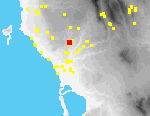 I25 Lefki Kaldtamou (#4)
I25 Lefki Kaldtamou (#4)
On the Kaldtamou ridge, SW of the village of Ambelofyto, five locations where prehistoric tumuli have previously been reported (UMME, collectively noted under #14; see also PHSP1: 239 [43]) were reinvestigated by PRAP.
A natural knoll, 2.1 km. SW of the outskirts of Ambelofyto, near the SW end of a ridge overlooking the Kaldtamou spring to the SE[095.28], has been bulldozed to create a complex of currant-drying floors; there is a small cinderblock fieldhouse with a vine-covered porch immediately to the NW. At the edge of the drying floors is a scarp with a shallow deposit of soil (0.4-0.6 m. deep) preserved on the bedrock. In 1991, bones were found projecting from this scarp. In 1993, at the NW corner of the scarp, a tile grave (two tiles with finger swirls[114.08]placed to form an inverted "V") was observed]. There are other fragments of tile in the scarp. Numerous (at least 50) slabs, some very large, are scattered about the knoll and reused as retaining slabs for currant-drying floors[095.33]. It seems clear that a cemetery existed here.
The ceramic finds from these tombs (I23-I27) are extremely mixed chronologically, from Classical to Modern, with one or two earlier pieces. It is impossible to provide any secure dates for many of the tiles.